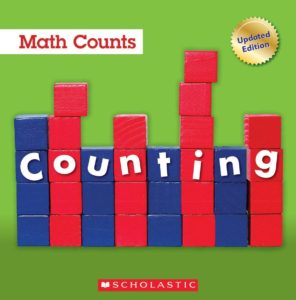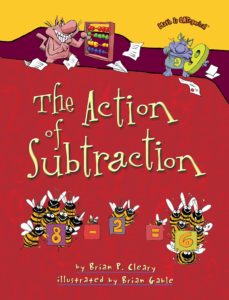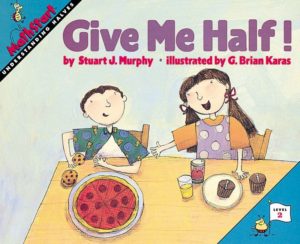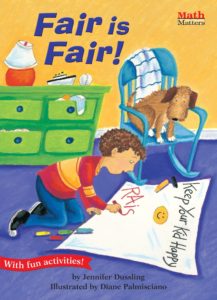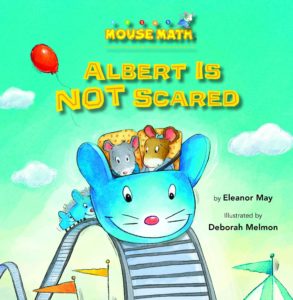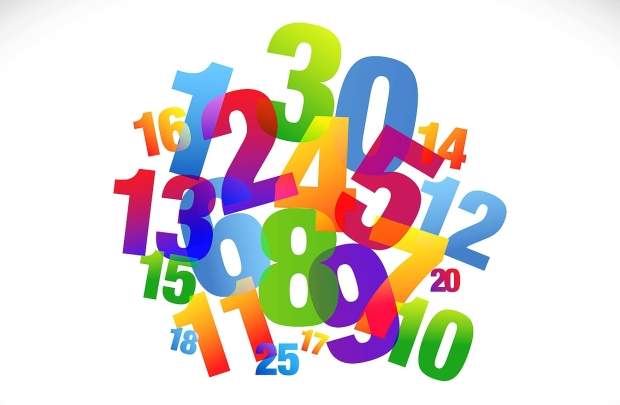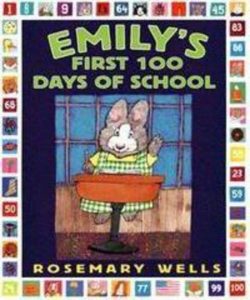 |
Rosemary Wells’s Emily’s First 100 Days of School (Disney-Hyperion, 2005) covers the numbers 1 to 100, with Emily’s daily number journal. Crammed with creative number ideas. (Make a number journal of your own!) Great project possibilities for ages 4 and up. |
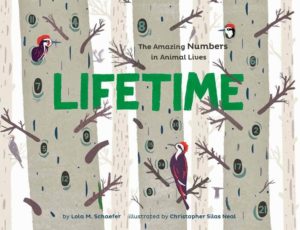 |
Lola M. Schaeffer’s Lifetime: The Amazing Numbers in Animal Lives (Chronicle Books, 2013), is a mix of biology and math, as kids learn numbers and cool animal facts from 1 to (with skips) 1000. For example, in a single lifetime, a spider will spin one egg sac, a caribou will shed ten sets of antlers, a woodpecker will drill 30 nesting holes in trees, a rattlesnake will add 40 beads to its rattle, and a pair of seahorses will produce 1000 baby seahorses. For ages 4-8. |
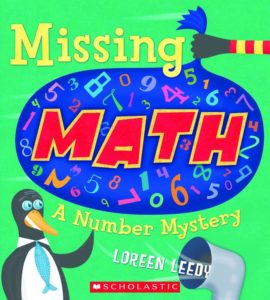 |
In Loreen Leedy’s Missing Math (Two Lions, 2008), all the numbers in town have simply disappeared – leaving behind a mess: clocks and calendars don’t work, money has no value, sports competitions and elections can’t be resolved, and nobody knows how old or tall they are. The culprit is finally caught: a number thief with a powerful vacuum, trying to make a number large enough to reach infinity. For ages 4-8. |
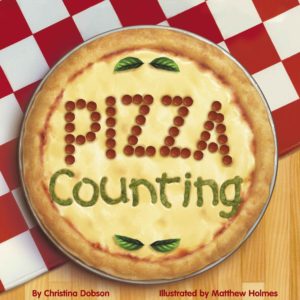 |
Christina Dobson’s Pizza Counting (Charlesbridge, 2003) covers counting, addition, large numbers, and fractions, all through the medium of creative and yummy-looking pizzas. Pizza toppings not only demonstrate the numbers 1-20, but are combined to make pictures, such as a pizza face, a pizza cat, a pizza clock. A pizza tricked out with 100 topping pieces is duplicated 10 times (to demonstrate 1000) and then 100 times (10,000); millions and biliions are discussed in terms of numbers of pizzas necessary to circle the globe or reach to the moon. Try pairing this one with making your own numerical paper or baked-in-the-oven pizzas. For ages 5-8. |
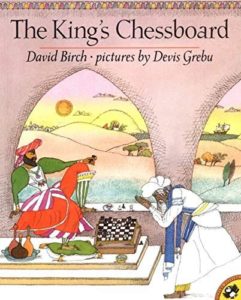 |
In David Birch’s The King’s Chessboard (Puffin, 1993), the king insists on giving his wise counselor a reward. Finally the counselor asks for a single grain of rice, the quantity to be doubled each day for as many days as there are squares on the king’s chessboard. The king soon realizes that he has made a dreadful mathematical mistake. For ages 6-10. |
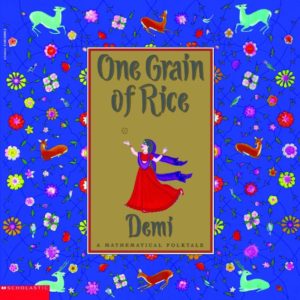 |
Demi’s One Grain of Rice (Scholastic, 1997) is a gorgeously illustrated version of the same tale, set in India; Helena Clare Pittman’s A Grain of Rice (Yearling, 1995) is a Chinese version of the story, in which a mathematically clever farmer’s son wins the hand of a princess. |
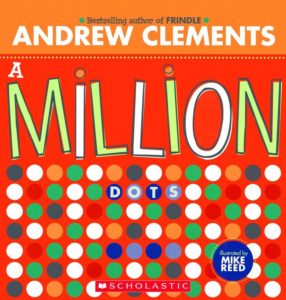 |
Andrew Clements’s picture-book A Million Dots (Simon & Schuster Children’s Publishing, 2006) contains one million dots, along with a lot of catchy factoids to help readers visualize crucial numerical quantities along the way. Kids learn, for example, that there are 525,600 minutes from one birthday to the next and that when the cow jumped over the moon, she soared upward 238,857 miles. For ages 4-8. |
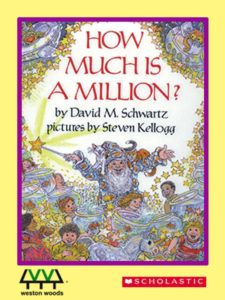 |
In David Schwartz’s How Much Is a Million? (HarperCollins, 2004), kids learn about millions, billions, and trillions, with the help of Marvelosissimo the Mathematical Magician and a lot of clever analogies. Readers discover, for example, that it would take 23 days to count to a million, that a goldfish bowl big enough for a million goldfish could hold a blue whale, and that a stack of a million kids, standing on each other’s shoulders, would reach all the way to the moon. For ages 4-8. |
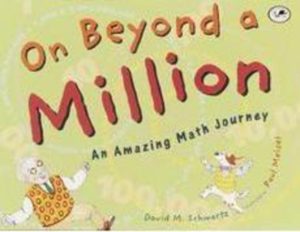 |
In David Schwartz’s On Beyond a Million (Dragonfly Books, 2001), Professor X and Dog Y (both in sweater vests) show kids how to count exponentially (by powers of ten). The book is appealingly designed, with conversation in cartoon bubbles and a lot of fascinating “Did you know?” side bars filled with numerical facts. For example, readers learn that one colony of weaver ants contains 500,000 ants, that there are 40,000 characters in Chinese, and that Americans eat 500,000,000 pounds of popcorn each year. Readers learn about the enormous googol (a 1 with a hundred zeroes after it) and the even more enormous googolplex (a googol raised to the power of a googol). However, they find that it’s impossible to count to infinity, and the book ends with: “No matter what number you have, there is always one bigger.”For ages 5-8. |
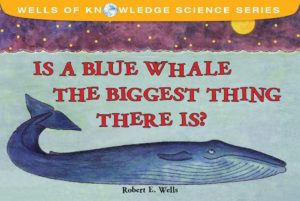 |
Robert E. Wells’s Is A Blue Whale the Biggest Thing There Is? (Albert Whitman & Company, 1993), for ages 6-9, is a cleverly illustrated exercise in big numbers and relative sizes: For example, it takes about 12 minutes to count to a thousand, but a good three weeks to count to a million, and a lifetime to count to a billion; and yes, a blue whale is big, but it’s tiny in comparison to massive Mount Everest, which is tiny in comparison to planet Earth, which is dwarfed by the Sun, which is puny compared to the red supergiant Antares. For ages 6-11. |
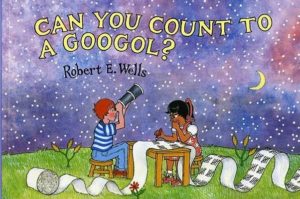 |
By Robert E. Wells, Can You Count to a Googol? (Albert Whitman & Company, 2000) is a counting book by tens (beginning with one banana, balanced on a nose) and moving up through 1000 (scoops of ice cream), 100,000 (marshamallows), and so on, ending with an explanation of the googol (a 1 with 100 zeroes after it) and how it was named by a nine-year-old boy. A googol, Wells points out, is much too enormous to illustrate (“If you counted every grain of sand on all the worlds’ beaches and every drop of water in all the oceans, that wouldn’t even be CLOSE…”). For ages 6-9. |
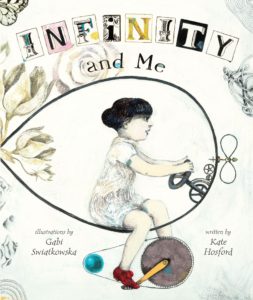 |
In Kate Hosford’s Infinity and Me (Carolrhoda Books, 2012), young Uma – gazing at the star-filled night sky – grapples with the difficult-to-grasp concept of infinity. Family and friends all offer different takes on infinity, and eventually Uma comes to terms with it, realizing that her love for her grandma is “as big as infinity.” With gorgeous illustrations by Gabi Swiatkowska. For ages 5-8. |












